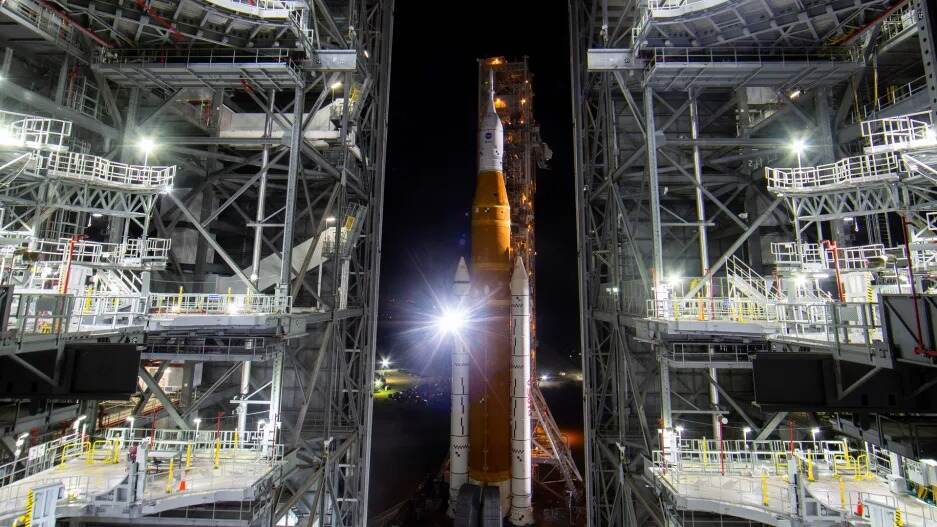- | 8:00 am
NASA’s Space Launch System—whenever it comes—will mark the end of an era for U.S. spaceflight
The odds of NASA ever ordering a rocket in the slow, expensive manner in which it procured SLS have fallen to near-zero as commercial space companies reinvent American spaceflight.

After a scrub Monday of the first flight of its massive Space Launch System rocket, NASA will regroup and aim to do something it last accomplished in 1981: inaugurate a rocket built to its design to transport astronauts to space.
And then NASA may never do it again.
SLS itself has more work to do after its scheduled Artemis I uncrewed lunar mission: Artemis II, projected for 2024, will take four astronauts around the Moon aboard an Orion capsule, followed by Artemis missions landing people on the Moon for the first time since Apollo 17’s December 1972 voyage.
But the odds of NASA ever ordering a rocket in the slow, expensive manner in which it procured SLS—and the space shuttle decades earlier—have fallen to near-zero as commercial space companies reinvent American spaceflight.
“I really think this the endpoint of the traditional approach to space development,” says John M. Logsdon, professor emeritus at the Space Policy Institute of George Washington University’s Elliott School of International Affairs. “The approach that was pioneered with commercial crew is much more likely to be the way forward.”
That more likely future is visible barely a mile and a half from the Artemis 1 launch facility, the Kennedy Space Center’s Pad 39B.
Pad 39A, the site of almost every Apollo and shuttle liftoff, is now rented by SpaceX and has served as the starting point of dozens of launches of its Falcon 9 rocket—including with astronauts—and three of its larger Falcon Heavy.
NASA and its congressional overseers had a different vision in 2011, when the agency announced the SLS project. They accepted privately developed vehicles delivering cargo to the International Space Station, but astronauts were different.
“NASA was reluctant to turn that over to the private sector,” said Lori Garver, deputy administrator of the agency from 2009 to 2013, at a conference in Washington in May.
Legislators had been even less amused by the Obama administration’s suggestion that NASA buy commercial crew transportation instead of building a new crew-capable, deep space rocket. “Congress was furious,” Garver recalled.
The agency committed to develop SLS as a heavy-lift shuttle successor built from shuttle components—like the earlier Constellation project, began in 2004 and canceled by Obama in 2010 after years of cost overruns and schedule slips. Like Constellation’s Ares V, SLS uses upgraded versions of the shuttle’s solid rocket boosters, strapped alongside a core derived from the shuttle’s external tank.
SLS not only employs the same main engine design as the shuttle, its four-engine first stage will feature rebuilt original shuttle engines on the first four flights. Logsdon’s comment on this recycling-heavy approach: “It really is a salvage effort!”
Unlike the shuttle, Falcon 9, and Falcon Heavy, none of SLS is reusable.
Manufacturing and tooling improvements were supposed to help SLS avoid the budget and schedule overruns that doomed Constellation. NASA estimated SLS and Orion, plus launch pad improvements, would cost $18 billion by the first SLS flight in 2017.
But NASA signed a traditional “cost-plus” contract with Boeing to develop SLS, in which the agency agreed to cover higher expenses as they arose but imposed little schedule or cost discipline.
Some $23 billion later, SLS seems set to fly, although when NASA will try again is not yet clear after Monday’s scrub of the planned launch because of a balky main engine that could not be brought to the correct super-cold temperature.
“The space sector does have a history of delivering over budget and behind schedule—but it does eventually deliver,” says Laura Forczyk, founder and executive director of the space consultancy Astralytical.
A successful debut would make SLS the world’s most powerful rocket, capable of lifting over 104 tons of payload to low Earth orbit.
That’s not as much as the 130 tons the Saturn V moon rocket could haul to orbit—a “Block 2” SLS with a stronger upper stage will beat that with a 143-ton capacity—but exceeds the 70 tons that Falcon Heavy can put into orbit.
The problem for SLS is that Congress didn’t budget anything for SpaceX to develop Falcon Heavy, which first flew in 2018. Last July, NASA chose to launch its upcoming Europa Clipper probe to that icy moon of Jupiter on a Falcon Heavy instead of the originally envisaged SLS, saving about $1.8 billion.
SpaceX has also developed the much larger, fully reusable Starship almost entirely on its own. And when that launches—which, after its own series of delays, may happen later this year—it will claim the heavy-lift crown with a low-Earth-orbit capacity of 110-plus tons.
NASA itself has picked SpaceX to develop a version of Starship’s second stage as its Artemis lunar lander. Under this concept, astronauts will fly to the Moon aboard an Orion, then rendezvous with a much larger Starship to journey the last few hundred miles.
“In a way, Starship is a gamble on the newer way of doing things,” says Forczyk.
Starship still needs to fly successfully and more than once. But if SpaceX can keep building on its demonstrated success, many observers of the space program do not expect SLS to be long for this world or others.
“I don’t think it’ll last 10 years—if Starship works,” Logsdon says. He expects five or six SLS launches.
The Obama appointee in charge of NASA when the SLS project began said as much two years ago.
“SLS will go away,” former administrator Charlie Bolden told Politico in September of 2020. “Because at some point commercial entities are going to catch up.”






































